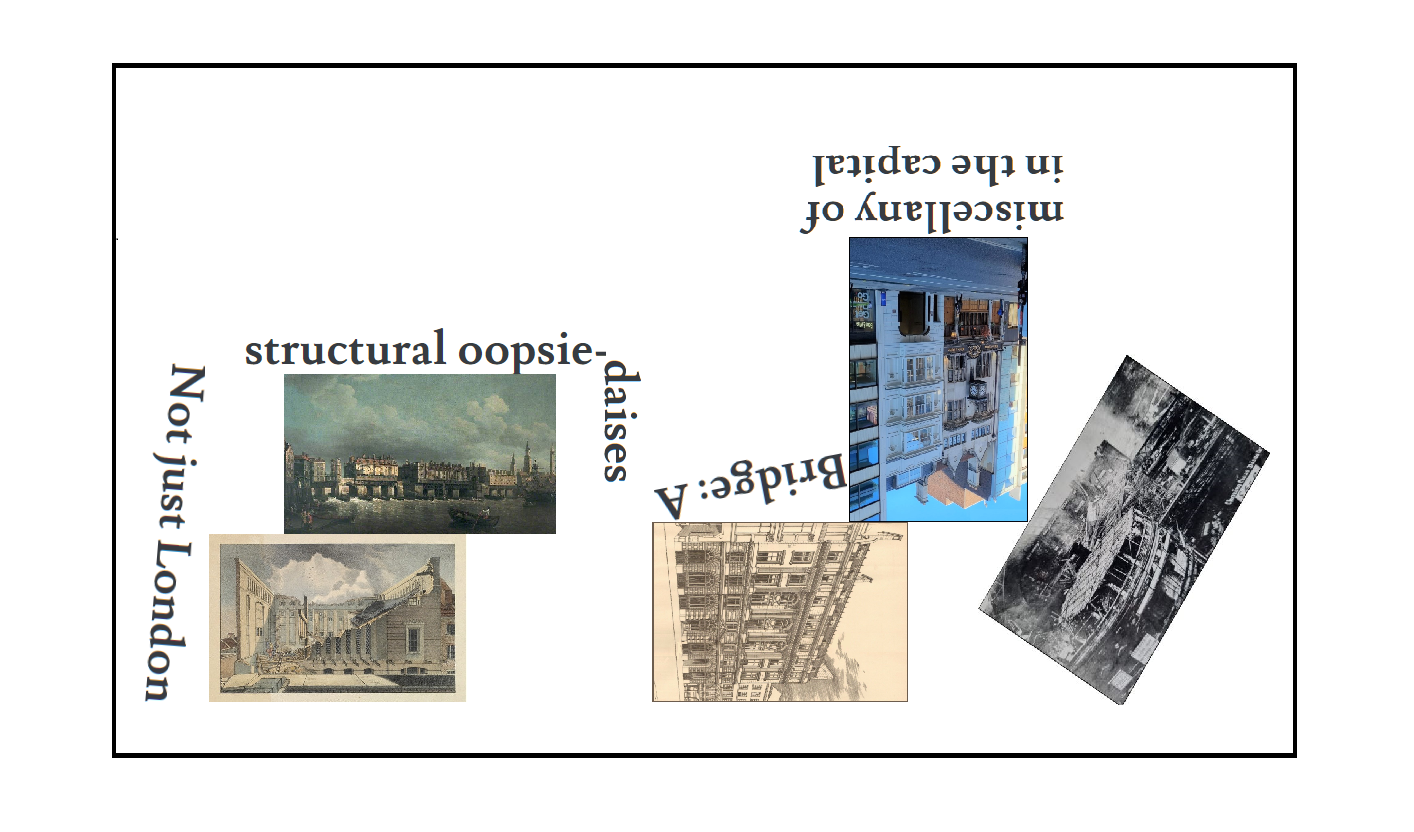
I recently heard, for the first time in years, the nursery rhyme that casts aspersions on the structural integrity of London Bridge. It reminded me that buildings falling down have been a problem since time immemorial, and continue to be so despite advances in technology. For this post I’ve put together a small miscellany of unusual incidents caused by poor design, subsidence or simple wear & tear.

It must be galling to the Bridge House Estates, the trust responsible for maintaining London Bridge for almost 750 years, that one of the oldest and most popular nursery rhymes in England suggests it hasn’t been doing its job. To be fair to that venerable organisation, it only received its Royal Charter in 1282, the year after the first great calamity; added to which, those who were charged with keeping Old London Bridge in good repair were working in extremely difficult conditions. The Thames was a fast flowing tidal river, constantly scouring the buttressed foundations (‘starlings’) of the nineteen piers. Maintenance was constant and expensive.
It was a tough job, and a queen dipping her hand in the till made it tougher still. The 1281 collapse was said to have been caused by ice from the frozen Thames crushing five arches. Queen Eleanor, unpopular wife of Henry III, was blamed by some as it was thought she had stolen the bridge revenues that should have gone towards paying for its upkeep; she may be the original ‘my fair lady’ of the nursery rhyme.
The 1437 collapse involved the great stone gate towards the south end. This was already known to be structurally unsound so the Bridge House Estates must admit some responsibility. Its fall took the two arches either side with it, along with nine buildings; these would have been some of the less expensive real estate – the north end of the Bridge, close to the City, was always the more desirable location. No casualties were reported on this occasion.
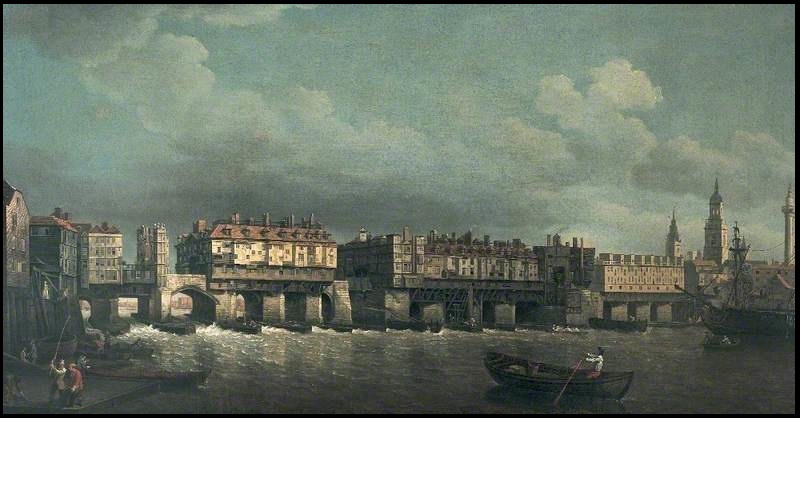
← Old London Bridge shortly before the buildings were removed in 1761. The rebuilt stone gate is the narrow building on the bridge, to the left
In addition to these two structural failures, a public lavatory or ‘common siege’ positioned over the river on the north end of the bridge collapsed in 1481. This sent five men to their deaths by drowning, presumably with their breeches around their ankles – a rather embarrassing way to go, although I doubt that was uppermost in their minds as they fell.

I’ve mentioned the Royal Brunswick Theatre before, in my post ‘A Load of Old Bollards’. It was built in Ensign Street, then known as Well Street, in the crime-infested and poverty-stricken ‘sailortown’ district close to St Katherine’s Dock and the Tower of London. The new theatre replaced a predecessor destroyed by fire, and was built in just seven months. It opened in 1828 and promptly collapsed just three days later, on the morning of Thursday 28th February, taking the Star pub, a bakery and a passing dray with it. Charles Dickens wrote an article in his weekly Journal, All The Year Round, and most of the following details come from that publication. Dickens wrote of the ‘tall and slight’ walls and ‘ponderous iron roof’ which were the agents of its destruction, and the ‘rather incompetent’ architect Stedman Whitwell, a man described in the Theatres Trust Guide to British Theatres (2000) as ‘somewhat eccentric’.
There were numerous warning signs in the days leading up to the tragedy, including box doors that wouldn’t close properly on the second night and a bulge appearing in the front wall the same day. The carpenter of Drury Lane Theatre Royal, called in by concerned workers, had pronounced the day before that the walls were neither strong enough nor dry enough to support the weight of the roof. Whitwell and the proprietors, Messrs. Maurice and Caruthers, refused to take any notice. Their obstinance meant that opportunities to add supporting struts were missed.
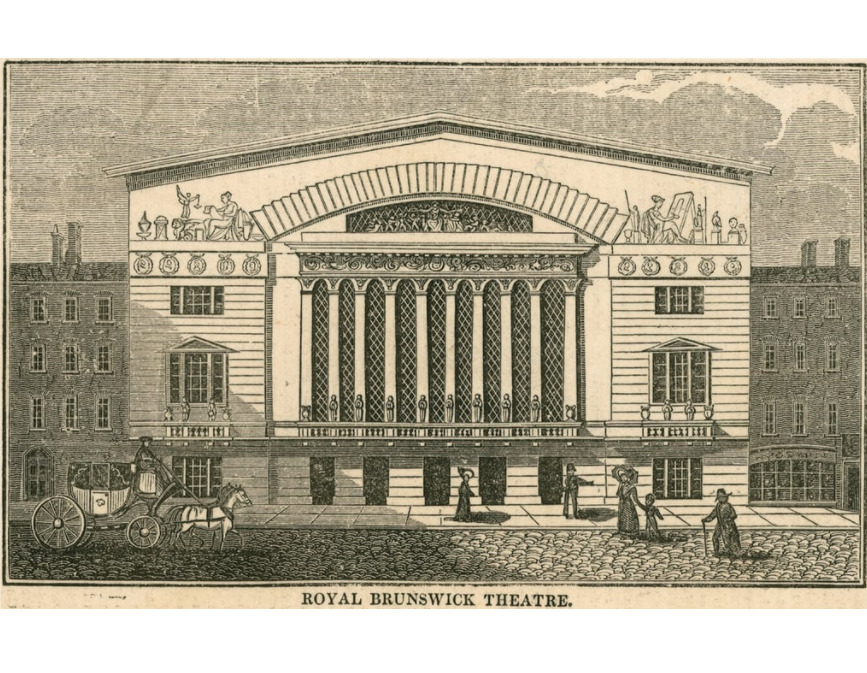
← An artist’s impression, presumably taken from plans. Capturing an image ‘from life’ would have proved difficult if the artist had a full diary the last week of February
The end, when it came, must have been terrifying for those inside. A slight crash as of timber being dropped, then another, and a prolonged rumble. One survivor said that he looked up to see the auditorium chandelier falling. That ponderous, heavy iron roof followed as the walls gave way.
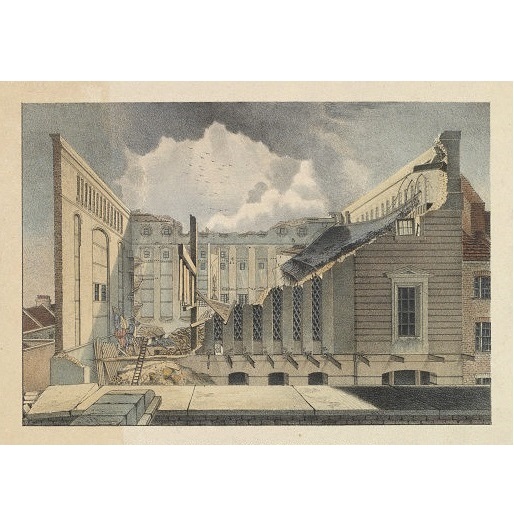
← The ruins, drawn from the roof of the building opposite.
One of the first on the scene of the disaster was a rather more respected architect, Philip Hardwick, who happened to be working nearby. He directed rescue efforts by labourers and sailors, but after the first few minutes no one was found alive in the rubble.
Fortunately, only a few workmen, actors, musicians and managers had been in the building. Had the collapse occurred on opening night, when 3,000 people were crammed in to the auditorium, the death toll could have been on a Titanic scale. As it was, only thirteen died, including Mr. Maurice, the majority shareholder. A fund to support the injured and bereaved raised £750. The inquest returned a verdict of accidental death, the actions of the proprietors being described as ‘highly reprehensible’.
The theatre was not rebuilt. Instead, moralising religious opponents established a mission to seamen officially called the Brunswick Maritime Establishment but known as the Sailors’ Home. At its peak this provided 500 beds a night, keeping sailors away from the many temptations of Sailortown, such as theatres. It was designed by Philip Hardwick, and has remained a hostel – under various guises – ever since. A row of bollards, each with the initials ‘RBT’, marking the frontage of a building that survived for just three days, have themselves survived for nearly two centuries, and are now listed.

On the afternoon of 21st April 1898, men were busy working on the recently laid concrete roof of Abbey Mansions, a seven storey office and residential block on Orchard Street, Westminster, that was nearing completion. Without warning, the roof collapsed. As it plunged down it took each successive floor with it. In a matter of seconds, all that remained of the interior was a pile of rubble, so high it reached from the basement floor to where the ground floor ceiling had been. Only the external walls remained standing. Seven workmen were killed, most instantly, four of whom had been on the roof. Five widows, nine children and one mother were left destitute. A relief fund was started by the local authority.
In the days and weeks that followed, discussions centred on the roof and the brick pier, or column, that should have helped hold it up. The various contractors, workmen, architect, foreman, owner and developer all pointed fingers at each other: The concrete was mixed wrongly; the girders weren’t properly bolted; there were no plans for the builders; the concrete roof had skylights in the wrong places; the temporary joists holding up the roof were removed too soon, against instructions; there were no instructions; the roof collapsed before the pier; the pier collapsed before the roof; the bricks used in the central pier were soft and crumbled and had been rejected at another building site; only the finest hard bricks were used; and so it went on. A reporter attending the inquest saw the “methods of the jerry builder [one who builds cheaply and flimsily] disclosed with startling distinctness”. The coroner admitted he had never before heard such contradictions in matters of fact.
The inquest found Charles Pawley, architect, guilty of culpable negligence in the design and construction of the pier and he was sent to trial, but acquitted of manslaughter at the Old Bailey: The prosecution decided not to proceed, deciding instead to disbelieve the evidence of the bricks, those who saw the pier give way, and indeed the verdict of the inquest. No one was punished, it seems, except the victims and their families. A replacement building with a different name was completed by 1901.

The new London terminus of the South East & Chatham Railway Company (SE&CR) opened in 1864 with a spectacular 165ft (50 metre) span roof over the platforms. The Avenue Theatre opened on an adjoining site in 1882. It was a speculative development by Sefton Parry, who believed that his neighbour would have to buy the plot for expansion and he would get handsome compensation. The station did eventually encroach onto the theatre site, but not quite in the way Parry had envisaged.
In 1905 the Avenue was in the hands of Cyril Maude, a well known actor-manager, and it closed for significant remodelling of the auditorium. The plan was to reopen under a new name, the Playhouse, the following year. On 5th December construction work was continuing in the theatre, while the SE&CR had the decorators in at Charing Cross; workmen in cradles suspended from the roof were busy painting the ironwork.
Approaching 4pm, the continental ‘boat’ express from Folkstone was due in, and a suburban service to Hastings was preparing to depart when the roof suddenly began showing signs of distress. A tie rod broke, the roof began to sag, and an evacuation of the station started. Barely ten minutes later, two bays of the roof fell onto the station below and the massive western supporting wall crashed onto the Avenue Theatre, destroying the upper floors and landing on the stage where the project architect was holding a meeting. Remarkably, all attending the meeting survived. Three men working on the station roof died, as did a kiosk worker in the employ of W.H. Smith, along with three men working in the theatre. The cause of the collapse was held to be the tie rod, which had an internal defect invisible to the eye.
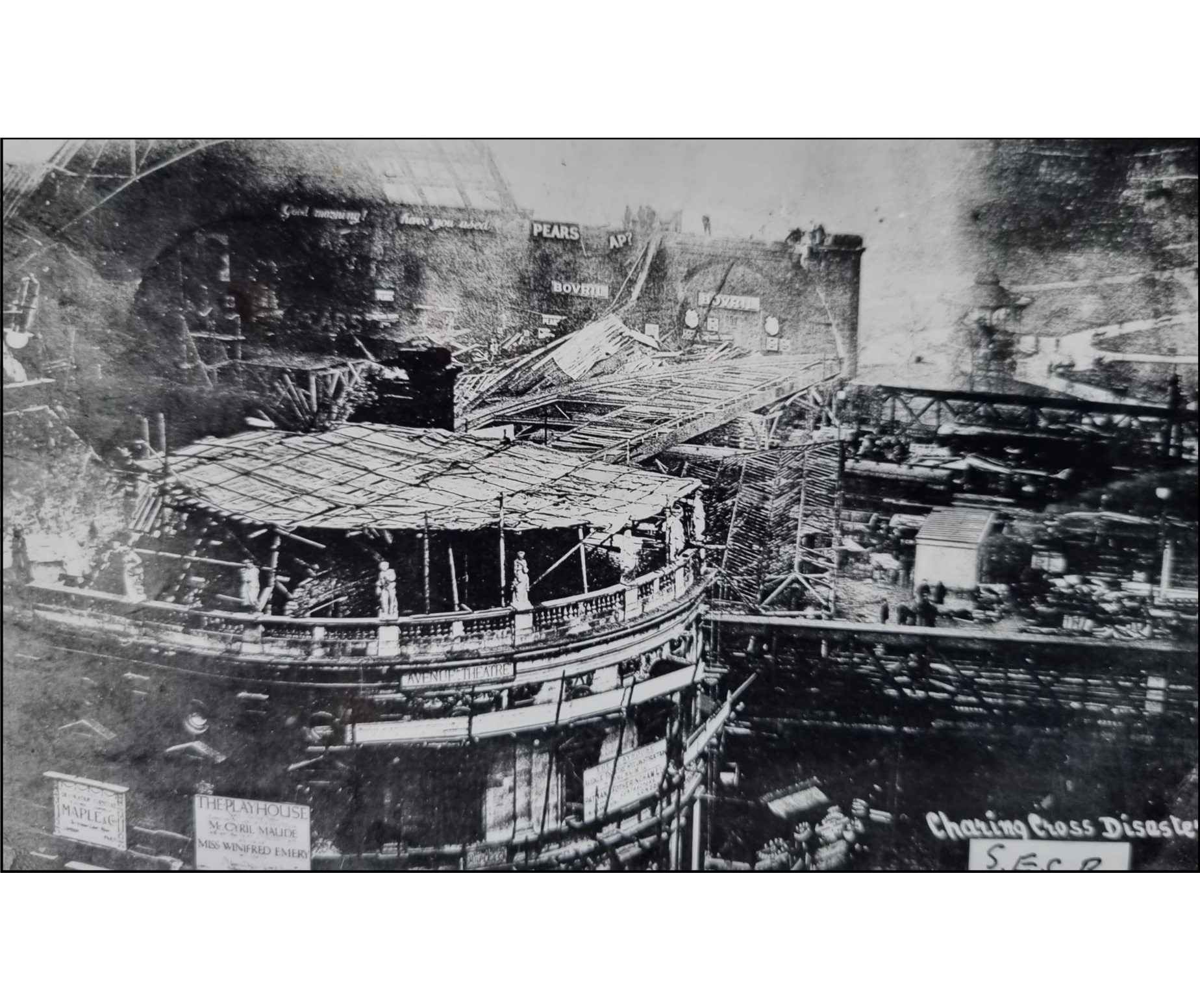
← Parts of the station roof lie across the top of the Avenue Theatre (front left). As there were around 100 workmen in the theatre, and trains and platforms had not been fully evacuated, it is a miracle there were only seven fatalities.
Compensation allowed Maude to rebuild the theatre internally, with only the exterior walls retained, and it finally reopened in January 1907. After serving time as a BBC studio for 20 years, it had an extra storey added to raise money for refurbishment and reopened as a theatre in 1991. The surviving parts of Charing Cross station roof were dismantled immediately after the disaster and replaced with something simpler, cheaper and safer. This in turn was replaced in 1986 by an office development perched above the platforms, designed to evoke memories of the original span.

← The Playhouse today with its extra storey, and the office block above Charing Cross Station, set further back than the original roof.
It has temporarily been renamed the Kitcat Club for an upcoming revival of Cabaret

City Grandees were stunned to wake up on Sunday 9th August 1927 to the news that Commercial Union, a major insurer, had collapsed. Not financially – in that respect it was in rude health – but physically.
Cornhill is a street in the heart of the financial district of London, a stone’s throw from Mansion House and the Bank of England, lined with financial institutions to this day. The villain of the piece is Lloyd’s Bank, building its new headquarters at number 22, next door to the insurer at number 24. Foundations were dug to the required depth, but without the required structural support for its unfortunate 34-year-old neighbour. Sounds of cracking and evidence of subsidence were noticed late on the afternoon of Saturday 8th August, which led to valiant attempts to pump concrete to underpin the 7-storey structure during the evening. As the state of the building became more precarious, a final evacuation of builders, along with caretakers in surrounding buildings, occurred at 10pm. The inevitable followed at midnight: One third of the Commercial Union building collapsed with an almighty roar. The only casualty was a workman who inhaled gas from a broken pipe. He made a full recovery.
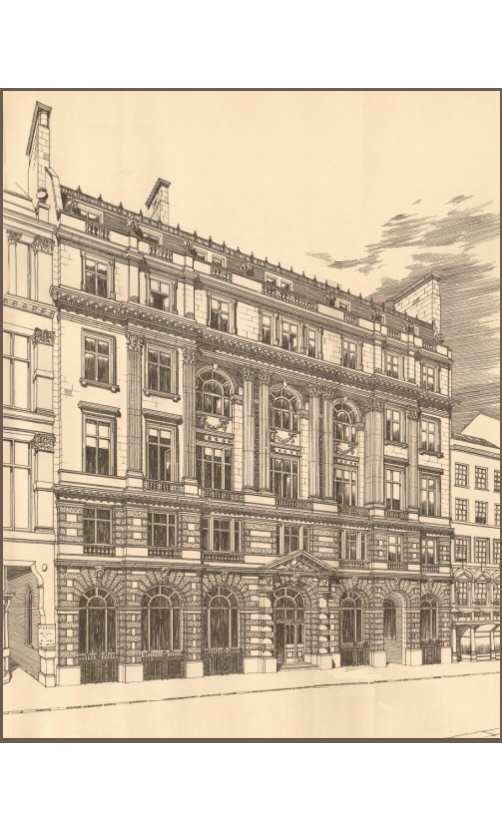
← The ill-fated 24 Cornhill, constructed in 1893. An over-fussy neo-classical design by Scottish architect John Macvicar Anderson, it was at least structurally sound – until Lloyd’s Bank came along.
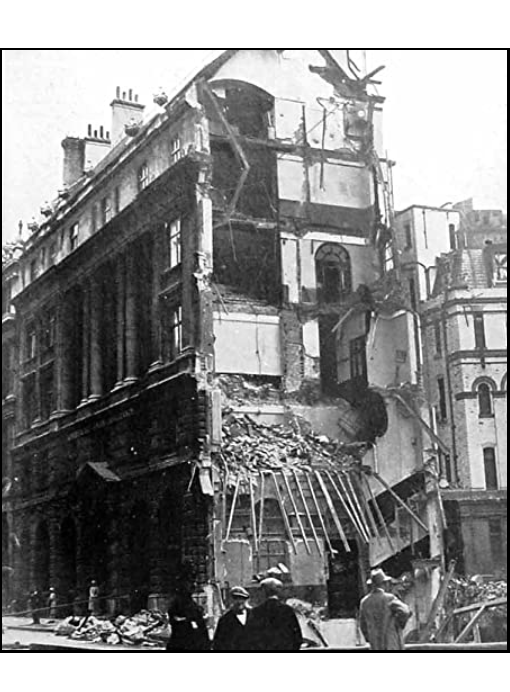
← Red faces at Lloyd’s. Two bays of their neighbour’s building were completed destroyed, the rest was structurally unsound. The first surviving bay nearest the camera housed an entrance through to Change Alley, historic heart of the financial district.
Barely twenty metres away, across the road, stood the south façade of the huge 1848 Royal Exchange. Initial assurances from authorities that the building was safe were undermined (excuse the pun) by the City Surveyor stating soon after that there was “an enormous mass of concrete at 22 and nothing under it”, which was followed rapidly by a large crack appearing in Cornhill closer to the Exchange. It became apparent that the void under 22 extended under part of the road. Huge supports were hurriedly constructed to keep the remains of 24 – and the Royal Exchange – standing.
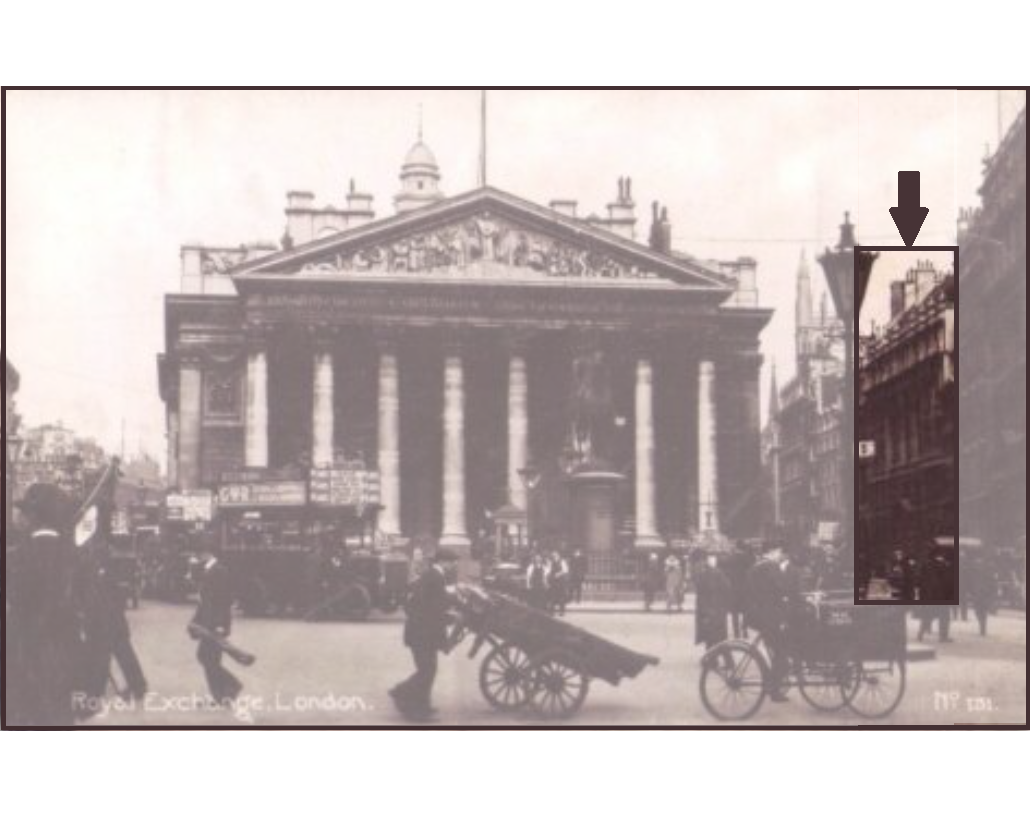
← The imposing western portico of the mighty Royal Exchange, designed by Sir William Tite, with the Commercial Union building highlighted – showing just how close it was, with only the unstable Cornhill between the two.
Within five days, in amongst road closures and traffic diversions, the most bizarre temporary measure needed as a result of the collapse was in place: A fully functioning telephone exchange 20ft (6 metres) down a hole in the road in front of the Commercial Union building. The operator stationed there – with, it is said, only rats for company – connected trunk calls between East London, Southend and Colchester.
Commercial Union hurriedly rebuilt its headquarters to a design by Maurice Webb, son of renowned architect Sir Aston. Ironically, the new building included a 4-level basement requiring excavations 50ft (15 metres) below ground level. A quirky building with Graeco-Roman detailing that still graces Cornhill, it rewards a closer look if you are passing. It was later used by Lloyds Bank so, ironically, it is the black horse that adorns the pediment.
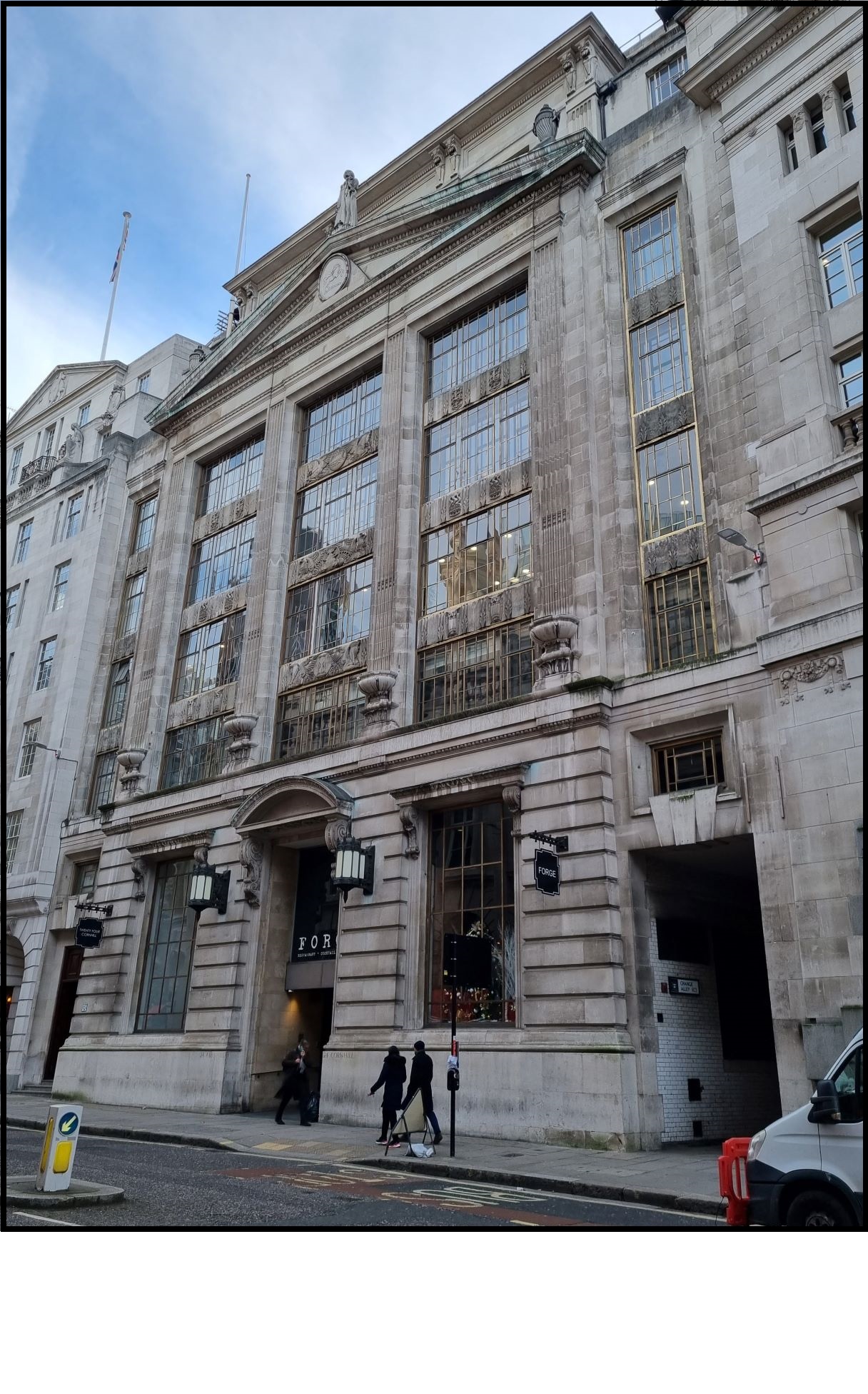
→ Maurice Webb’s 1929 24 Cornhill now houses a bar and nightclub on the ground floor. It is listed grade II. There is still an entrance to Change Alley through the building, on the right.
An architect who was also an expert in unsafe buildings commented on the widespread belief that vibration caused by traffic was the root cause of the collapse, suggesting that:
“There are so many buildings in London that simply hold together for old association’s sake. The passing of a big motor lorry preys heavily on their feelings”

Thirty-eight years later, the developers of the insipid 20 High Holborn really should have kept those words in mind. In a repeat of the Cornhill incident, this development caused the loss of a neighbour, the gatehouse into Gray’s Inn, one of the four inns of court.
To the west of the gatehouse lay the 1924 Cittie of York, a pastiche-Tudor pub. In contrast to the pub the gatehouse was the real Tudor deal, constructed in 1583 with a stucco frontage added in 1867. It had survived the great fire (by about 200 metres), Zeppelin raids of the First World War, and more remarkably the Blitz – when much of Gray’s Inn itself was destroyed. What it couldn’t survive was the redevelopment of its neighbour to the east: Excavations for foundations led to subsidence and the final collapse of the almost 400-year-old building. There were no injuries.
The gatehouse, a listed structure, was rebuilt with the stucco south façade completed in 1967. It has recently been refurbished along with its erstwhile executioner, and in 2021 was renamed Lady Hale Gate after Brenda Hale, who served as President of the Supreme Court for three years until 2020.
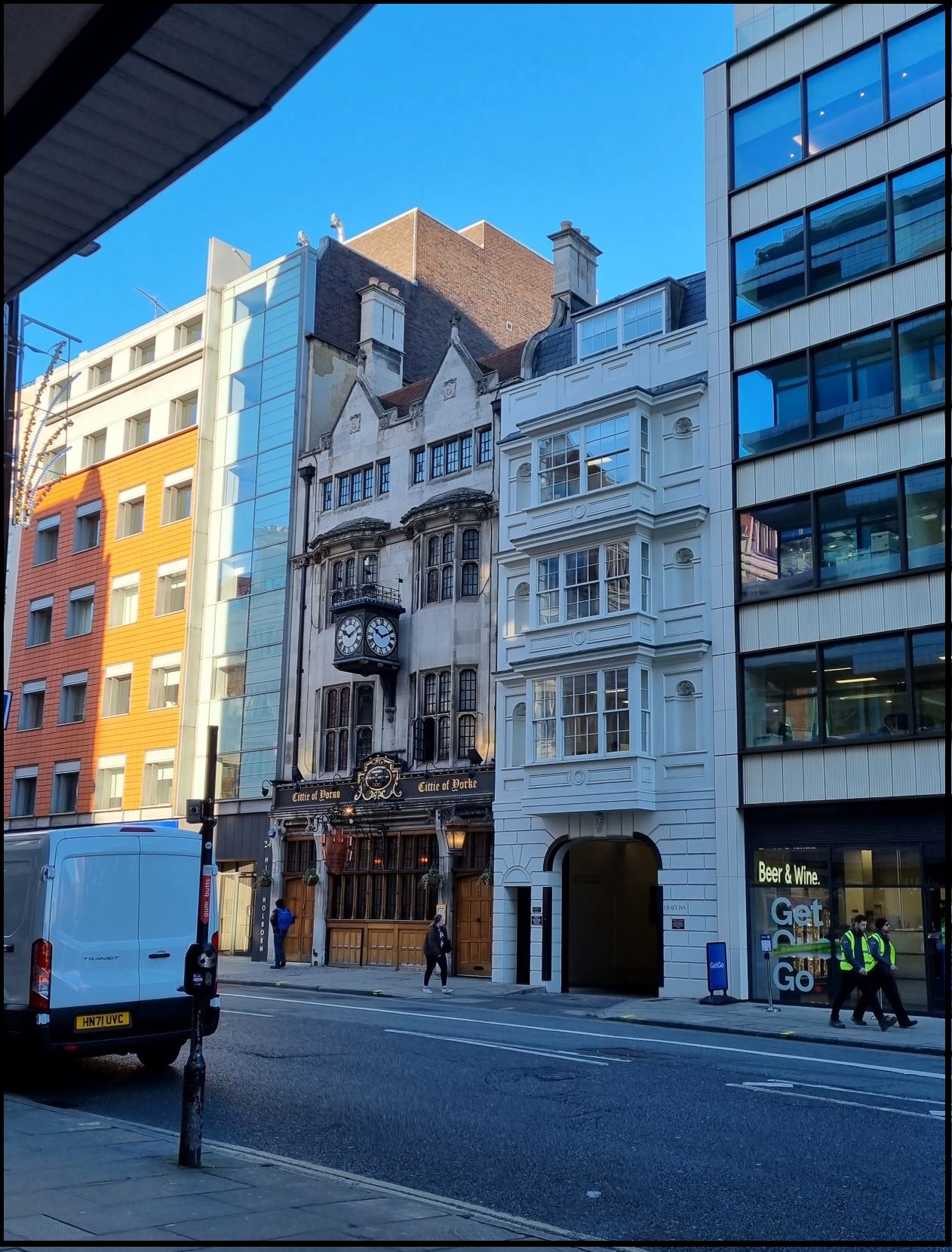
→ The rebuilt gatehouse, in white stucco, sandwiched between the pastiche Cittie of York, ironically now its senior in age, and the tedious 1960s 20 High Holborn, recently refurbished to look exactly like it did before the refurbishment.

There is an embarrassment of riches when it comes to stories of falling theatre ceilings. I’ve opted to recount here an incident at the Shaftesbury Theatre in 1973. This had opened as the New Princes Theatre in 1911.
Situated at the north end of Shaftesbury Avenue and designed by renowned theatre architect Bertie Crewe, the exterior is in an elaborate renaissance style, but due to its relatively small size fails to make a significant impact – the prominent corner site really needed something more monumental and shouty-shouty. Almost immediately after opening, it was apparent that its poor position meant it would need to fight for an audience. Although regular seasons of Gilbert & Sullivan were hugely successful, many other offerings were not, and it was regarded by some as a white elephant. Adopting in 1963 the name of another theatre, destroyed in the Blitz, didn’t seem to help. It did, however, have occasional successes away from Messrs. G&S. The biggest of all was Hair, the ‘American Tribal Love-Rock Musical’, famed for its on-stage nudity and drug references. This opened the day after theatre censorship was abolished in 1968, and played its 1,997th performance on the 19th July 1973. It was destined not to reach 2,000, at least not at the Shaftesbury. In the early hours of Friday 20th, a month before the show was due to close, part of the ceiling fell into the deserted stalls area. As with the Royal Brunswick, a case of ‘had it been just a few hours earlier …’.
What makes this incident particularly interesting is the series of events it set in motion in the weeks and months following. The run of Hair was effectively terminated. The sale of the theatre by EMI to Peureula Investments was triggered, as it had been agreed this would occur at the end of the run. The subsequent ‘dangerous structure’ notice issued by Camden Council gave Peureula a golden opportunity to press ahead with their plans to redevelop the site. The staff were dismissed and theatre salvage companies told they could take what they like from the building – demolition was imminent. But round-the-clock picketing of the theatre by actors and other theatre professionals prevented the stripping of the interior by workmen. There followed a prolonged battle which only ended with the Shaftesbury’s listing in March 1974.
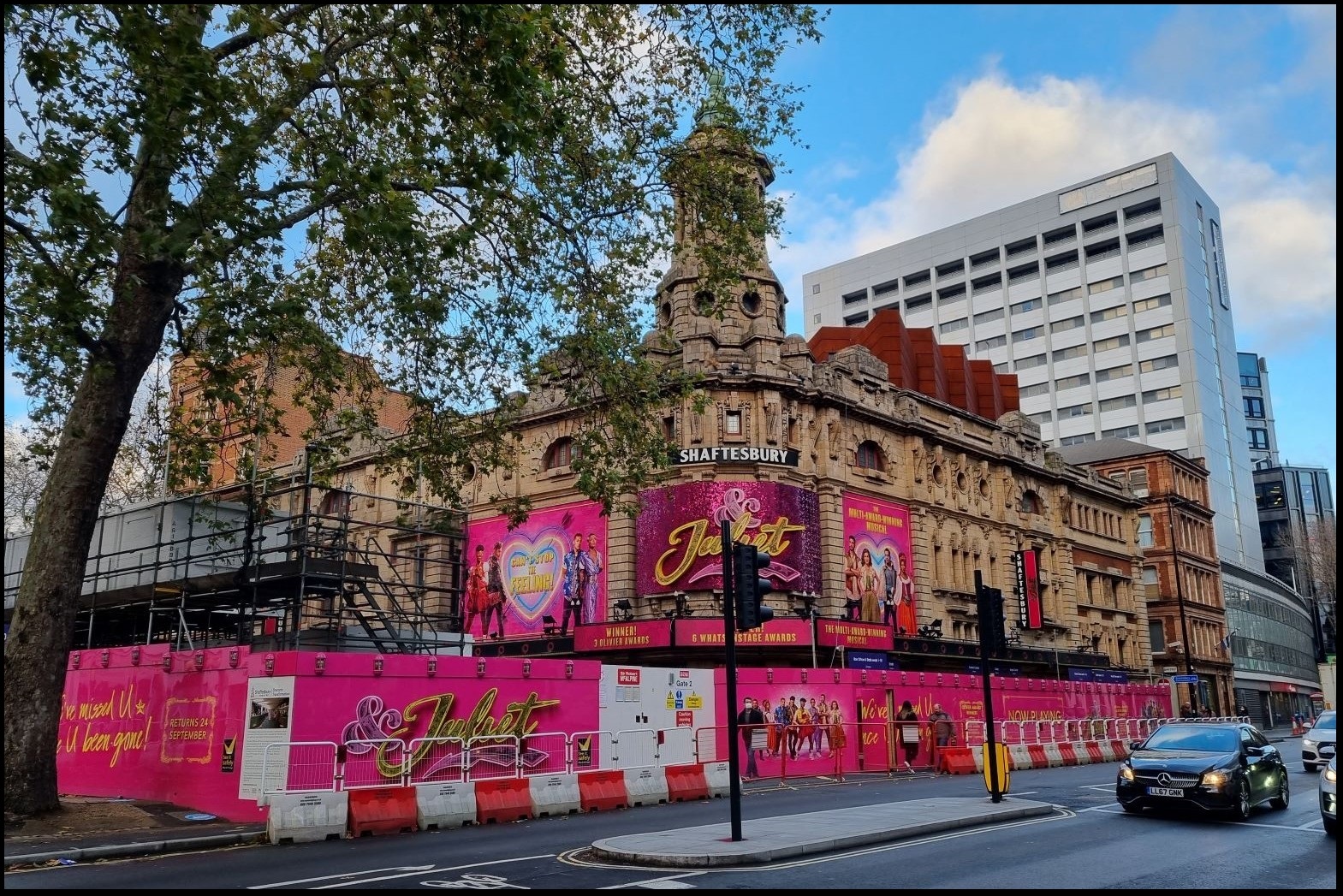
← The Shaftesbury, December 2021, showing evidence of the money now being lavished on the building – including a new fly tower and vast underground hospitality rooms under the road in front.
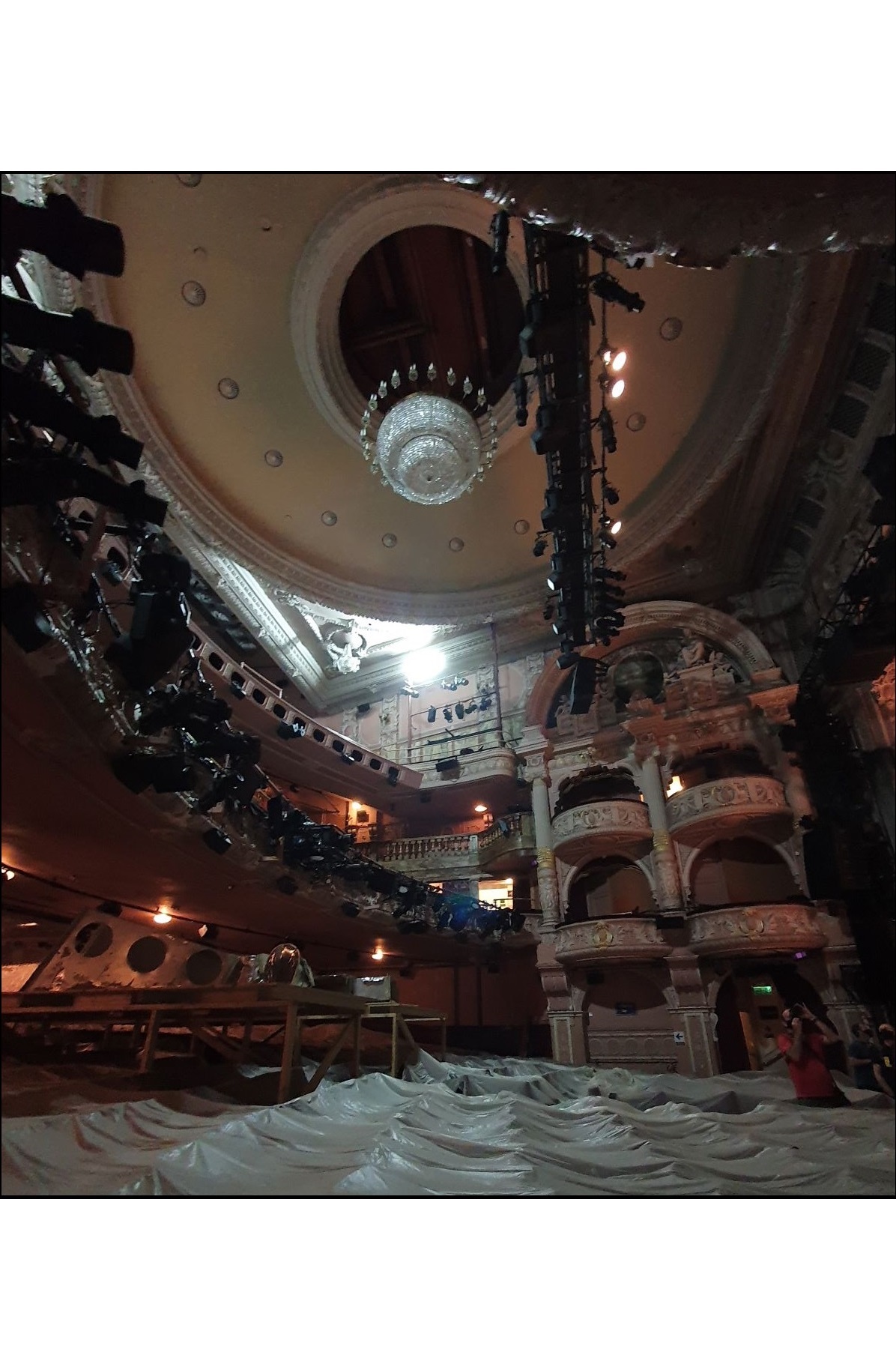
→ The guilty ceiling, now restored. The auditorium is shown during the 2020 works.
The Shaftesbury reopened with a revival of West Side Story in December 1974. Hair did finally reach its 2,000th performance, when it reopened in June 1974 for a short run at the nearby Queen’s Theatre.
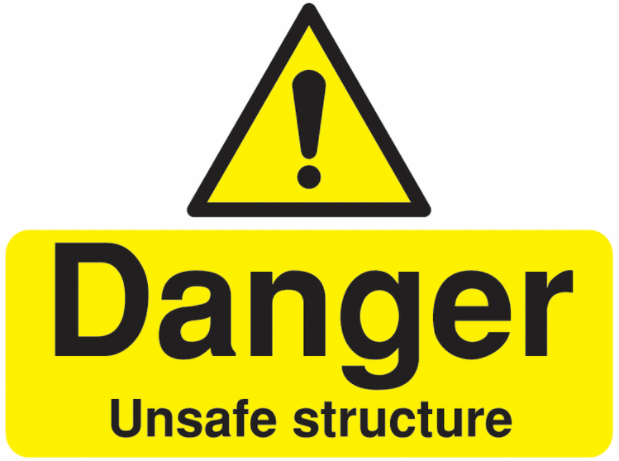
Nearest Stations:
Selected Bibliography:
Credits: